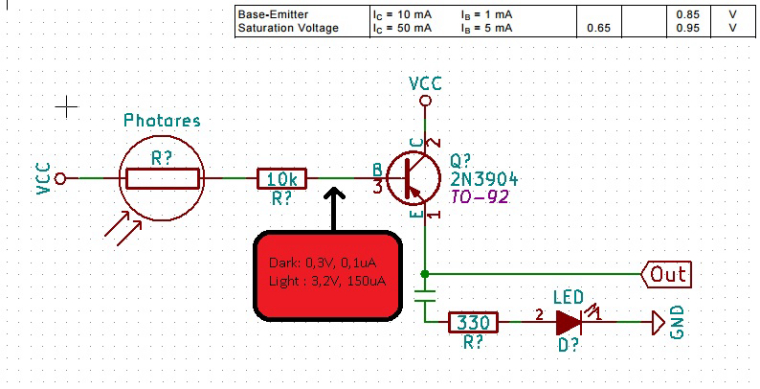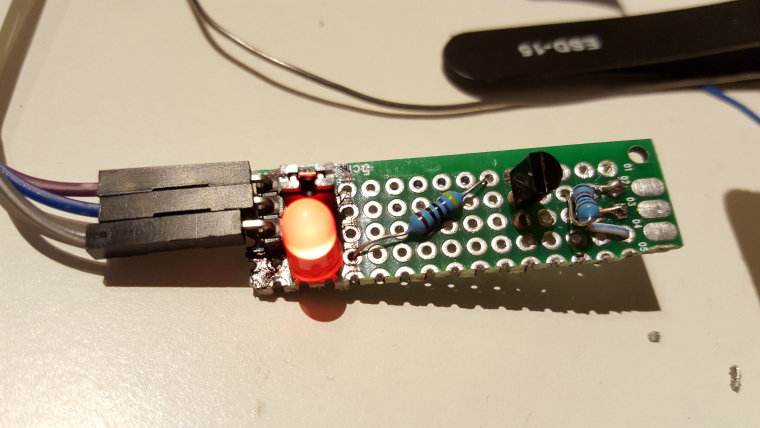💬 Power Meter Pulse Sensor
-
It appears to be the controller that stores the value. I deleted the sensor from HomeAssistant and restarted, when it came back in again it started from zero.
This is a hack, but if using json persistence, you can set the count in the JSON file and restart home assistant, with the node turned off. Then turn on the node.
-
This is a hack, but if using json persistence, you can set the count in the JSON file and restart home assistant, with the node turned off. Then turn on the node.
@martinhjelmare Yep, I figured I could do that. The absolute value is not so important actually, I'm more interested in the daily/weekly delta, which I hope Grafana can tell me.
-
is this the same sensor than the one in the guide?
http://uk.farnell.com/ams/tsl250r-lf/photodiode-sensor-l-volts/dp/1182346Can I also use also photoresistor? (Since I already have one)
@gohan - nope its not the same, and yes you can use a photoresistor (i have just made one) but I needed a transistor for it to work and also it had to be completley dark. Using this on batteries its much better using just a photoresistor because the sensor in the guide draws about 1mA which will drain the batteris very quickly.
I will post my sensor later.
Edit: this is the sensor i build:


The node (including pro mini) draws about 50uA sleeping and 170uA not sleeping.
The photoresistor was 5M ohm in complete dark. -
The guide specifies LM393 Light Sensor or the tsl250r-lf so I thought it was the same since the same name.
Since the node will be powered with it's power supply, I don't have any battery drain problem in this case. But why did you use a transistor? Can't you just check for a threshold value in the analog input to count as a pulse? -
The guide specifies LM393 Light Sensor or the tsl250r-lf so I thought it was the same since the same name.
Since the node will be powered with it's power supply, I don't have any battery drain problem in this case. But why did you use a transistor? Can't you just check for a threshold value in the analog input to count as a pulse?Ok, all I can see is that it doesnt look the same at all.
@gohan - I tried, and I thought that should work - but for some reason I could not get it to trigger the interupt on the atmega :(
Looking the the voltage thresholds it was supposed to work but it didnt. I was thinking it was to low uA but i dont know really. -
This is what I use togeheter with LM393
https://www.kjell.com/se/sortiment/el-verktyg/elektronik/optokomponenter/ir-dioder-fototransistorer/fototransistor-p90042 -
Ok, all I can see is that it doesnt look the same at all.
@gohan - I tried, and I thought that should work - but for some reason I could not get it to trigger the interupt on the atmega :(
Looking the the voltage thresholds it was supposed to work but it didnt. I was thinking it was to low uA but i dont know really.Instead of the 10k resistor, do you think I could use a potentiometer to "adjust" sensitivity? I would like to avoid messing up the readings with lights entering when opening the cabinet door where the meter is located
@flopp
Do you mind sharing your wiring? 940nm, isn't it infrared? -
Instead of the 10k resistor, do you think I could use a potentiometer to "adjust" sensitivity? I would like to avoid messing up the readings with lights entering when opening the cabinet door where the meter is located
@flopp
Do you mind sharing your wiring? 940nm, isn't it infrared?@gohan - a potentiometer is just a variable resistor so why not? Good idea if you have one laying around.
As i said before though, the try with the transistor is just a try - im not that good with transistors yet and dont know how they work exactly. After this i read somewhere that the base resistor should be bigger to protect the transistor... dont know how to calculate that. -
Instead of the 10k resistor, do you think I could use a potentiometer to "adjust" sensitivity? I would like to avoid messing up the readings with lights entering when opening the cabinet door where the meter is located
@flopp
Do you mind sharing your wiring? 940nm, isn't it infrared?@gohan said in 💬 Power Meter Pulse Sensor:
@flopp
Do you mind sharing your wiring? 940nm, isn't it infrared?I connected the photo resistor directly to the LM393.
I don't know if that is IR. -
Hello,
First, thanks for this tutorial !
I used the code defined in tutorial but I have the following message for "void receive(const MyMessage &message)" :'MyMessage' does not name a typeDo you know what can be the cause of this error please ?
Thanks in advance for your help
-
Hello,
First, thanks for this tutorial !
I used the code defined in tutorial but I have the following message for "void receive(const MyMessage &message)" :'MyMessage' does not name a typeDo you know what can be the cause of this error please ?
Thanks in advance for your help
-
@moumout31 do you have void receive(const MyMessage &message) somewhere in your code or where does it come from?
Could you post the full error message?Have you installed the MySensors library?
@mfalkvidd void receive(const MyMessage &message) is in the code.
MySensors library is installed, I already use it in other nodes.
It's strange because it works in another computer...The full error messages, in french beacause I'm french are :
Arduino : 1.8.0 (Windows 7), Carte : "Arduino Pro or Pro Mini, ATmega328 (3.3V, 8 MHz)" _02_Main_loop:271: error: 'MyMessage' does not name a type In file included from C:\Users\Anne-Laure\Documents\Arduino\libraries\arduino_759467/MySensors.h:257:0, from C:\Users\Anne-Laure\Dropbox\Maison\A récupérer sur OneDrive\my_teleinfo_light\_02_Main_loop.ino:118: C:\Users\Anne-Laure\Documents\Arduino\libraries\arduino_759467/core/MyTransport.cpp: In function 'void transportProcessMessage()': C:\Users\Anne-Laure\Documents\Arduino\libraries\arduino_759467/core/MyTransport.cpp:745:14: error: cannot resolve overloaded function 'receive' based on conversion to type 'bool' if (receive) { ^ C:\Users\Anne-Laure\Documents\Arduino\libraries\arduino_759467/core/MyTransport.cpp:811:15: error: cannot resolve overloaded function 'receive' based on conversion to type 'bool' if (receive) { ^ exit status 1 'MyMessage' does not name a type Bibliothèque non valide trouvée dans C:\Users\Anne-Laure\Documents\Arduino\libraries\MySensors : C:\Users\Anne-Laure\Documents\Arduino\libraries\MySensors Ce rapport pourrait être plus détaillé avec l'option "Afficher les résultats détaillés de la compilation" activée dans Fichier -> Préférences.Thanks for your help
-
@mfalkvidd void receive(const MyMessage &message) is in the code.
MySensors library is installed, I already use it in other nodes.
It's strange because it works in another computer...The full error messages, in french beacause I'm french are :
Arduino : 1.8.0 (Windows 7), Carte : "Arduino Pro or Pro Mini, ATmega328 (3.3V, 8 MHz)" _02_Main_loop:271: error: 'MyMessage' does not name a type In file included from C:\Users\Anne-Laure\Documents\Arduino\libraries\arduino_759467/MySensors.h:257:0, from C:\Users\Anne-Laure\Dropbox\Maison\A récupérer sur OneDrive\my_teleinfo_light\_02_Main_loop.ino:118: C:\Users\Anne-Laure\Documents\Arduino\libraries\arduino_759467/core/MyTransport.cpp: In function 'void transportProcessMessage()': C:\Users\Anne-Laure\Documents\Arduino\libraries\arduino_759467/core/MyTransport.cpp:745:14: error: cannot resolve overloaded function 'receive' based on conversion to type 'bool' if (receive) { ^ C:\Users\Anne-Laure\Documents\Arduino\libraries\arduino_759467/core/MyTransport.cpp:811:15: error: cannot resolve overloaded function 'receive' based on conversion to type 'bool' if (receive) { ^ exit status 1 'MyMessage' does not name a type Bibliothèque non valide trouvée dans C:\Users\Anne-Laure\Documents\Arduino\libraries\MySensors : C:\Users\Anne-Laure\Documents\Arduino\libraries\MySensors Ce rapport pourrait être plus détaillé avec l'option "Afficher les résultats détaillés de la compilation" activée dans Fichier -> Préférences.Thanks for your help
-
@moumout31 My guess is that MyMessage is defined in your sketch, overriding the definition in the MySensors library. Could you post your sketch?
@mfalkvidd It's strange... It works with an older version of Arduino software... Thus, the problem is solved ! Thanks
-
Hello,
I don't understand why, but my power meter sensor gives a higher index than the real power meter index after 2 days.
I think that it counts more pulses than pulses provided by the power meter...
Does anybody encounter this problem ?
Can it be cause to bounce for example ?Thank you
-
Hello,
I don't understand why, but my power meter sensor gives a higher index than the real power meter index after 2 days.
I think that it counts more pulses than pulses provided by the power meter...
Does anybody encounter this problem ?
Can it be cause to bounce for example ?Thank you
-
Hello,
I don't understand why, but my power meter sensor gives a higher index than the real power meter index after 2 days.
I think that it counts more pulses than pulses provided by the power meter...
Does anybody encounter this problem ?
Can it be cause to bounce for example ?Thank you
@moumout31
I had same issue, check here for my solution
https://forum.mysensors.org/topic/4716/two-energy-meter/4 -
@moumout31
could it be getting some light from another source?@gohan No, the light is always switched off in this room and I tried, when I switch on the light, there is no pulse from the sensor.
@flopp Thanks for your help. What I see in your topic is that you increase from 10000µs to 40000µs the interval to avoid corrupted interrupts, is that correct ?
Thank you
